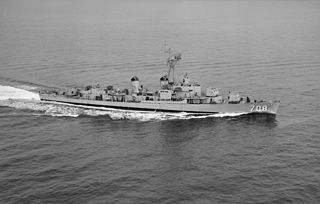
USS Dyess (DD/DDR-880), a Gearing-class destroyer, was a ship of the United States Navy named for Aquilla James Dyess (1909–1944). Dyess was awarded the Medal of Honor posthumously for his leadership of his battalion of Marines in the Battle of Kwajalein. The ship was laid down by Consolidated Steel Corporation at Orange, Texas on 17 August 1944, launched on 26 January 1945 and commissioned on 21 May 1945. The vessel spent the majority of her career patrolling the Mediterranean Sea with NATO forces. The ship was decommissioned on 27 January 1981 and sold to Greece the same year for spare parts.

USS Furse (DD-882/DDR-882) was a Gearing-class destroyer of the United States Navy.

USS Newman K. Perry (DD-883/DDR-883), was a Gearing-class destroyer of the United States Navy.

USS Stickell (DD-888) was a Gearing-class destroyer of the United States Navy. She was named for Lieutenant John H. Stickell USNR (1914–1943), who was killed in action at Jaluit Atoll in the Marshall Islands on 13 December 1943 and posthumously awarded the Navy Cross. She was renamed HS Kanaris (D212) on transfer to the Hellenic Navy in 1972.

USS Hawkins (DD-873) was a Gearing-class destroyer in the United States Navy during World War II. Following the war, the ship saw service in the Korean War and in the 1970s, was transferred to the Republic of China Navy as Tze Yang. She remained in service until the 1990s. The ship was then scrapped with the exception of her superstructure, which became part of a display and training ground at the Zuoying Naval Academy.

USS Charles R. Ware (DD-865), was a Gearing-class destroyer of the United States Navy in service from 1945 to 1974. After her decommissioning, she was sunk as a target in 1981.

USS Hale (DD-642), a Fletcher-class destroyer, was the second ship of the United States Navy to be named for Maine Senator Eugene Hale (1836–1918).

USS Myles C. Fox (DD/DDR-829) was a Gearing-class destroyer in the United States Navy during World War II and the years following. She was named for Myles C. Fox, a USMC lieutenant who was posthumously awarded the Navy Cross for actions during World War II.

USS Harlan R. Dickson (DD-708), an Allen M. Sumner-class destroyer, was named for Lieutenant Commander Harlan Rockey Dickson.

USS Charles H. Roan (DD-853) was a Gearing-class destroyer of the United States Navy. The ship was named after Charles Howard Roan, a United States Marine who lost his life in action on the island of Palau during World War II.

USS Hyman (DD-732), was an Allen M. Sumner-class destroyer of the United States Navy.

USS Henley (DD-762), an Allen M. Sumner-class destroyer, was the fourth ship of the United States Navy to be named Henley, was named after Captain Robert Henley ; an officer in the United States Navy during the Quasi-War with France, the War of 1812 and the Second Barbary War.

USS William R. Rush (DD/DDR-714) was a Gearing-class destroyer in the United States Navy during the Korean War. She was named for William R. Rush.

USS William M. Wood (DD/DDR-715) was a Gearing-class destroyer in the United States Navy during the final year of World War II. She was in commission for 31 years, from 1945 through 1976, serving in both the Pacific and Atlantic Fleets. She was the second Navy ship named for Navy Surgeon-General William M. Wood (1809–1880).

The third USS Keppler (DD/DDE-765) was a Gearing-class destroyer in the United States Navy during the Korean War and the Vietnam War. She was named for Boatswain's Mate First Class Reinhardt J. Keppler (1918–1942), who was posthumously awarded the Medal of Honor for "extraordinary heroism" during the Naval Battle of Guadalcanal.

USS Turner (DD/DDR-834) was a Gearing-class destroyer of the United States Navy, the third Navy ship named for Captain Daniel Turner (1794?–1850).

The third USS Lloyd Thomas (DD/DDE-764) was a Gearing-class destroyer in the United States Navy during the Korean War and the Vietnam War.

USS Dennis J. Buckley (DD/DDR-808) was a Gearing-class destroyer of the United States Navy.

USS Goodrich (DD/DDR-831) was a Gearing-class destroyer of the United States Navy, named for Rear Admiral Caspar F. Goodrich (1847–1925), and his son, Lieutenant Caspar Goodrich.

USS Robert L. Wilson (DD/DDE-847) was a Gearing-class destroyer of the United States Navy, named for Marine Private First Class Robert L. Wilson (1920–1944), who was posthumously awarded the Medal of Honor for "conspicuous gallantry" in the Battle of Tinian.





















